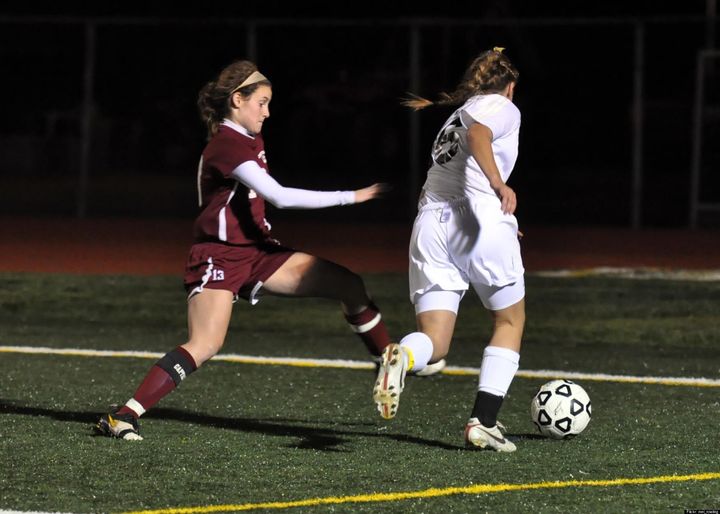
William hits the neon-colored ball with a powerful forehand; his opponent barely makes contact and the return lands short. William springs towards the ball like a gazelle and, with unfettered force, aims the volley deep. The ball ricochets off his racquet and lands, again, inside the baseline. His opponent shakes his head, disgusted.
William pumps his fist -- but immediately winces and reaches for his right shoulder. He has just won the first round of the United States Tennis Association sectional tournament at Port Chester, NY., but, walking towards his mother, flushed and perspiring, says "My right shoulder's killing me."
A 12 year old, top 10 Eastern Sectional player, William has been plagued with a right shoulder injury for several months. "William played a lot of heavy duty competitive matches in a row; that got it going," says his mother, Amy Tardio. (She asked that her son's surname be omitted to avoid harming his incipient career.)
After William's injury, his parents took him to see Dr. Kennneth Palmer, an orthopedic surgeon in White Plains. "Over the last 10 years, I've seen kids coming in at younger and younger ages, like William, with shoulder and elbow problems," Palmer says. X-rays showed nothing seriously wrong with William, who's now undergoing physical therapy and strength training.
But the incidence of athletic injuries among youth is growing, especially among specialists who play a single sport four, five or more times a week, Palmer says. High school sport participation has grown from 4 million in 1971-72 to over 7 million today, according to the National Federation of State High School Association's survey last year. Adolescent athletes annually sustain approximately 1.4 million injuries, the Center for Injury Research and Policy at Nationwide Children's Hospital, Ohio, announced last year, and up to half of all injuries seen in pediatric sports medicine are related to overuse, the American Association of Pediatrics reported in 2007.
Jordan Metzl, M.D., a sports medicine physician and author of 'The Young Athlete' treats about 50 young adults a week and 3,000 a year, at his office at the Hospital for Special Surgery in Manhattan, commonly for overuse injuries, stress fractures, injuries to growth plates and tendonitis.
How prevalent and serious are such injuries in kids?
The drive to excel at a young age comes from: parents who live vicariously though their kids, private coaches who drive kids with a 'No pain, no gain' philosophy, and children who dream of getting into elite colleges and playing professionally, says Randall Wroble, an Ohio orthopedic surgeon and co-author of 'Combat Sports Medicine.'
Overuse injuries can affect the tendons, muscles or ligaments, Palmer says. "Usually rest is enough and rarely do kids continue to play, causing ligament, tendon or muscle ruptures," he says. Stress injuries that lead to bone inflammation can affect knees, heels, shoulders and elbows. "When kids stop playing, inflammation goes down and the pain goes away," he continues. Most of these injuries are growth-related. "When kids finish growing, the growth plates fuse together and these issues disappear," he says.
"A concept driven by parents and coaches is that as kids work harder on one sport, they will be better prepared to play that sport," says Bob Moore, physical therapist and founder of the Moore Physical Therapy Center in Connecticut. "But that's an error. In Connecticut there's been only one pitcher, Kevin Morton, picked to play major league baseball. He might be the only first round draft choice in the last 20 years from Fairfield, yet we are seeing more 12, 13, 14-year-old baseball pitchers playing baseball year-round."
As younger children participate year-round at a high level, their injuries begin to resemble high schoolers, says Wroble. "A classic example is the torn ACL in the knee, which no surgical procedure can make brand new," he says. "We don't bat an eye when we see this in a eight or nine-year-old, which 20 years ago, would have been unique. This is the tip of the iceberg; unless we look at prevention, its going to get bigger."
Given that youth sport specialization is a growing issue, what's the solution?
Metzl's recommendation, backed by the American Academy of Pediatrics, is that sports specialization is risky until kids reach 12 or 13. "It puts too much physical stress on certain areas of the body," Metzl says. "In kids, their skeletal's are growing and developing; their cartilage growth plates at the end of their bones are prone to injury as they are much softer than regular joints in adults." He also believes specialization can cause psychological damage. "The pressure of doing well gets narrowed down to one category of sport or event; this pressure on kids is not healthy."
Children who specialize, despite such warnings, should at least maintain a good training routine, Palmer advises. "Kids need more conditioning, not running miles or lifting weights but stretching and strengthening," he says. In addition, "parents have to be very attuned to when a kid is pushed too hard; too many injuries is a red flag."
Amy Tardio, William's mother, meanwhile is following Palmer's instructions to be watchful for injuries. "We made a few adjustments, changed the string on his racquets, took some rest time and are working on his flexibility," she says. "Tennis is a long road and you want them to be healthy."